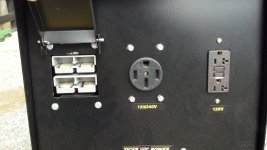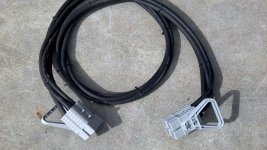I recently got a good deal on a Voltmaster PTO 15/12 generator on craigslist. While it ran great the volt meter is hard to see from the tractor seat and while I could have marked the gauge so I could just rev the tractor until the needle is in the green I thought I would try and add a better option.
I ordered a volt - current - watts - frequency digital meter just to see if it would be better. I ordered a
ACM2-4-AC1-R-F-C Murata Power Solutions Inc. | Industrial Controls | DigiKey
This meter is self powered and it can read up to 100 amps.
Here is a picture of where I started.
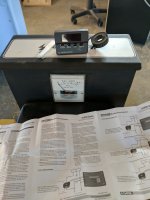
There are 3 connections for the meter, a positive, negative and one of the main current wires needs to go through the transformer. If you look at your generator there is already going to be a voltage connection for the existing meter and that is what I used for my meter. There are really not a ton of wires you just need to make sure you keep the polarity straight. My meter had it marked, if yours doesn't you can figure it out from your generator wiring diagram. Here is a picture of my generator with the back cover removed. The original volt meter is still connected.
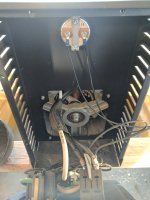
The generator is a 2 pole and so it just had 3 large wires coming from it. Two are 120V legs and a neutral. I chose to hook it up so it would read the 240 voltage, but there are also wiring diagrams for the 120v if that is what you prefer. You do need to pay attention to the coil as it is directional. The dot goes toward the generator. You will want to look inside of your machine before you order this meter as the current coil only has about 3-4 inches of wire so you can't run it deeper into the generator unless you plan to cut and splice the wires. My generator the main power wires ran right behind the gauge so I was OK. Just something to keep in mind.
Here is a picture of the meter stuck through the existing hole. If you look you can see the black shiny current coil just inside the hole, One of the main current wires is running through it but because the wire is black you can't really see it. The white wire is the neutral so I have no connections to it. it just happens to run right beside the 2 black power wires. The wires sticking out of the generator are my voltage wires I am going to hook to the meter.
Here it is all hooked up and running. The voltage is a little off but it is close enough for me and I didn't bother to track down if it was a connection that made it off or if the meter I received was a little off. You can have the meter calibrated by sending it off if you really desired but I was more concerned with frequency which is very close and actually matched the meter most of the time, I just happened to catch when it jumped the tenths digit for a second.
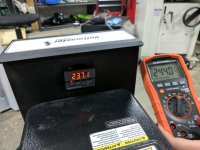

I can easily see it from the tractor and you can either select which reading it will start up on and after going you can push the select button for 3 seconds and it will continuously cycle through all settings. I go off of the cycles so the voltage being off isn't a killer. I also have not calibrated my hand held meter. I know it is going to kill some people but I have access to 17025 calibrated equipment and I have not verified my meter against it.
Let me know if you have any questions but if nothing I hope that this post shows that it isn't terrible hard to do this yourself. If you have issues with the meter on your generator, take your time and read the directions and you can do it yourself.
I ordered a volt - current - watts - frequency digital meter just to see if it would be better. I ordered a
ACM2-4-AC1-R-F-C Murata Power Solutions Inc. | Industrial Controls | DigiKey
This meter is self powered and it can read up to 100 amps.
Here is a picture of where I started.

There are 3 connections for the meter, a positive, negative and one of the main current wires needs to go through the transformer. If you look at your generator there is already going to be a voltage connection for the existing meter and that is what I used for my meter. There are really not a ton of wires you just need to make sure you keep the polarity straight. My meter had it marked, if yours doesn't you can figure it out from your generator wiring diagram. Here is a picture of my generator with the back cover removed. The original volt meter is still connected.

The generator is a 2 pole and so it just had 3 large wires coming from it. Two are 120V legs and a neutral. I chose to hook it up so it would read the 240 voltage, but there are also wiring diagrams for the 120v if that is what you prefer. You do need to pay attention to the coil as it is directional. The dot goes toward the generator. You will want to look inside of your machine before you order this meter as the current coil only has about 3-4 inches of wire so you can't run it deeper into the generator unless you plan to cut and splice the wires. My generator the main power wires ran right behind the gauge so I was OK. Just something to keep in mind.
Here is a picture of the meter stuck through the existing hole. If you look you can see the black shiny current coil just inside the hole, One of the main current wires is running through it but because the wire is black you can't really see it. The white wire is the neutral so I have no connections to it. it just happens to run right beside the 2 black power wires. The wires sticking out of the generator are my voltage wires I am going to hook to the meter.
Here it is all hooked up and running. The voltage is a little off but it is close enough for me and I didn't bother to track down if it was a connection that made it off or if the meter I received was a little off. You can have the meter calibrated by sending it off if you really desired but I was more concerned with frequency which is very close and actually matched the meter most of the time, I just happened to catch when it jumped the tenths digit for a second.


I can easily see it from the tractor and you can either select which reading it will start up on and after going you can push the select button for 3 seconds and it will continuously cycle through all settings. I go off of the cycles so the voltage being off isn't a killer. I also have not calibrated my hand held meter. I know it is going to kill some people but I have access to 17025 calibrated equipment and I have not verified my meter against it.
Let me know if you have any questions but if nothing I hope that this post shows that it isn't terrible hard to do this yourself. If you have issues with the meter on your generator, take your time and read the directions and you can do it yourself.

